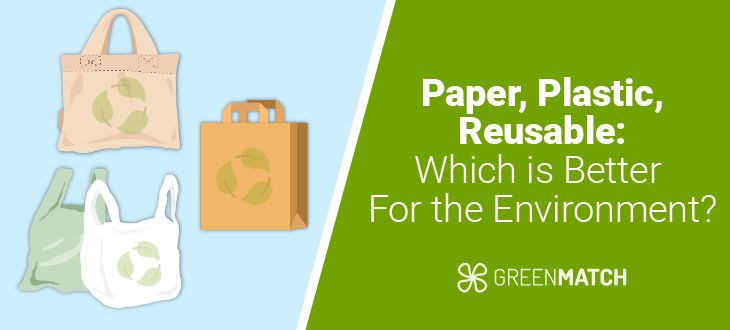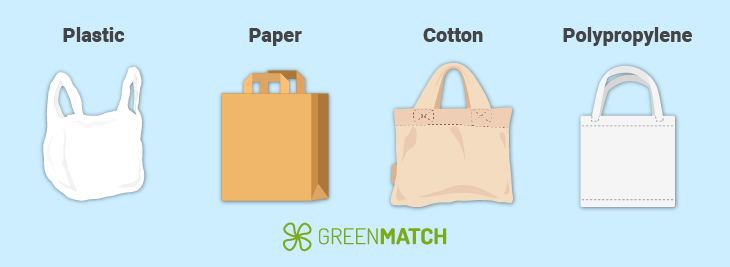- GreenMatch
- Blog
- Which Bag is Greener: Plastic, Paper, or Reusable?
Which Bag is Greener: Plastic, Paper, or Reusable?


- Plastic bags have a low carbon footprint but are hard to recycle and don't break down easily
- Paper bags decompose quickly but need four times more water to produce than plastic bags
- Reusable bags reduce waste if used frequently, despite higher initial environmental costs
Several factors come to mind when considering the environmental and practical implications of plastic, paper, or reusable bags. These factors include sustainability, durability, cost, and convenience.
As we strive to make environmentally conscious decisions, understanding the implications of these choices becomes a crucial factor in our decisions. This elevated our global struggle with pollution, particularly the effects of fossil fuels, incineration, and microplastics.
The discussion around the sustainability of everyday items, including grocery bags, suggests we must do something.
What do We Mean by Plastic, Paper, or Reusable Bag?
When discussing the environmental impact of shopping bags, we consider several factors. These may include the resources needed during the manufacturing process, the carbon emissions, the times they may be reused, and what happens at the end of their lifecycle.
Therefore, which sort of plastic, paper, or reusable bag has the least negative influence on our environment?
Making the right choice regarding our shopping bag involves more than just the use and satisfaction. The impact on the environment and how it can significantly affect it determines which we go for.
Therefore, when deciding between plastic, paper or reusable bags, we must look at their entire lifecycle, from production to disposal. Each bag type has advantages and challenges, affecting factors like carbon emissions, water usage, and waste generation.
| Bag Type | Production Water Consumption (litres) | Carbon Emissions (g CO2 equivalent) | Lifespan (reuses) | Waste Generated (Kg) | CO2 Emissions (kg) per Bag |
|---|---|---|---|---|---|
| Plastic Bag | 1.5 | 0.7 | 1 | 0.2 | 0.04 |
| Paper Bag | 4.5 | 2.5 | 3 | 0.5 | 0.08 |
| Reusable Plastic Bag | 6.0 | 2.7 | 100 | 0.3 | 6.00 |
| Reusable Cloth Bag | 130.0 | 4.0 | 400 | 0.1 | 5.52 |
Environmental Impact of Plastic, Paper, or Reusable Bags
Choosing the most environmentally friendly bag depends on how often it is reused. For instance, single-use plastic bags have the smallest carbon footprint peruse but cause significant long-term pollution.
On the other hand, paper bags are biodegradable but resource-intensive. Reusable bags, especially those made from cotton, must be used often to offset their higher production impact. Reusing any bag as frequently as possible is the key to minimising environmental harm.
What is the Impact of Paper, Plastic, or Reusable Bags?
Total Impact Per Year
- Plastic Bags: The production of 5 trillion plastic bags annually often produces significant greenhouse gas emissions and pollution. Only a small percentage is recycled, with the majority ending up in landfills or oceans. For example, before the 5 pence charge was introduced in the UK, about 7.6 billion single-use bags were used as shopping carriers in the supermarket.
- Paper Bags: The production of paper bags involves cutting down millions of trees and consuming vast amounts of water and energy. This leads to higher carbon emissions and environmental degradation.
- Reusable Bags: If not reused enough, the production of reusable bags, especially cotton ones, can result in a larger carbon footprint than single-use plastic bags. The accumulation of unused reusable bags also poses a storage and waste problem.
Impact Per Day
- Plastic Bags: Daily use of plastic bags contributes to the accumulation of plastic pollution in the environment. For example, Americans use about 1 plastic bag per person daily, leading to significant daily waste.
- Paper Bags: Daily production and use of paper bags consume large amounts of water and energy, contributing to daily environmental degradation.
- Reusable Bags: The daily impact depends on the frequency of reuse. If reused daily, reusable bags can significantly reduce the need for single-use bags. However, infrequent use diminishes their environmental benefits.
Impact Per Usage
- Plastic Bags: Single-use plastic bags have the smallest carbon footprint peruse but cause long-term environmental harm due to their persistence in the environment.
- Paper Bags: Each use of a paper bag has a higher environmental cost compared to plastic. They need to be reused multiple times to offset their initial environmental impact. This means that a paper bag must be reused 3 times to match the carbon footprint of a single-use plastic bag.
- Reusable Bags: The environmental impact per use decreases with increased reuse. Cotton bags need to be reused 50-150 times, while polypropylene bags need to be reused 11 times to break even with plastic bags.
Statistics, Facts and Figures About Shopping Bags
According to different environmental sources, the numbers behind bag usage and production paint a startling picture of our consumption habits.
Here is a breakdown of some key statistics that would help you choose a more sustainable choice for your shopping:
| Bag Type | Production Energy (kWh) | Reuses Needed to Offset Impact | Global Production (annually) | Average Lifespan | Recycling Rate |
|---|---|---|---|---|---|
| Plastic | 0.5 | 1-2 times | 5 trillion | 12 minutes | 5-7% |
| Paper | 1.5 | 3-7 times | 14 billion | 1 month | 80% |
| Cotton | 2.5 | 131-7,100 times | 500 million | 4 years | 90% |
- Globally, we use about 5 trillion plastic bags per year.
- Less than 1% of plastic bags are recycled.
- A cotton bag needs to be used 50 to 150 times to have less climate impact than a single-use plastic bag.
- Paper bags require about four times as much water to produce as plastic bags.
- Non-woven polypropylene bags must be reused only 11 times to break even with conventional plastic bags.
- In the UK, plastic bag usage dropped by 95% after introducing a 5p charge.
- Some regions now face excess bags, creating new waste challenges.
- The EU aims to reduce annual plastic bag consumption to 40 bags per person by 2025.
- As of 2024, 91 nations have implemented full or partial bans on plastic bags.
- The reusable bag market is growing rapidly, with experts projecting that it will reach £12.83 billion by 2029, up from £10.55 billion in 2022.
- Plastic bags are derived from petroleum, which contributes to pollution if not properly recycled.
- A cotton bag needs to be reused 131 times to match the environmental impact of a single-use plastic bag.
- Polypropylene bags, while more durable, still require significant resources to produce
Environmental Impact Breakdown
- Greenhouse Gas Emissions: Plastic bags produce 0.04 tons of CO2, equivalent to paper's 0.08 tons.
- Water Usage: Plastic bags produce 58 gallons of fresh water, while paper bags require a staggering 1,004 gallons.
- Energy Consumption: Plastic bags need 763 megajoules of energy to produce, versus 2,622 megajoules for paper.
- Waste Generation: Plastic bags create 7kg of municipal solid waste, while paper bags generate 33.9kg
When deciding between paper, plastic and reusable bags, it's important to consider their environmental effects.
Plastic Bags
- Production and Use: It is estimated that about 100 billion plastic bags annually, with only about 4% being recycled.
- Environmental Impact: It is estimated that producing 1,500 plastic bags uses 14.9 kg of fossil fuels 7 kg of municipal solid waste, and emits 0.04 tons of CO2.
- Recycling and Disposal: Only a small percentage of plastic bags are recycled. Most end up in landfills or as litter, contributing to marine pollution and microplastics.
Paper Bags
- Production and Use: Manufacturing paper bags requires significant resources. For instance, producing 1,000 paper bags uses 23.2 kg of fossil fuels, 1,004 gallons of water, and emits 0.08 tons of CO2.
- Environmental Impact: Paper bags contribute to deforestation and require four times as much water as plastic bags.
- Recycling and Disposal: Paper bags are biodegradable and easier to recycle than plastic bags.
Reusable Bags
- Production and Use: Reusable bags, often made from cotton or polypropylene, have a higher initial environmental cost.
- Environmental Impact: Cotton cultivation is resource-intensive, requiring water, pesticides, and fertilisers.
- Recycling and Disposal: The key benefit of reusable bags lies in their repeated use, which significantly reduces their overall environmental footprint.
Environmental Impact Comparison
| Bag Type | Fossil Fuels Used (kg) | Energy Usage (MJ) | Water Used (gallons) | CO2 Emissions (tons) | Reuses Needed to Offset Impact |
|---|---|---|---|---|---|
| Plastic (1,500 bags) | 14.9 | 763 | 58 | 0.04 | 1 |
| Paper (1,000 bags) | 23.2 | 2,622 | 1,004 | 0.08 | 1-2 |
| Cotton (1 bag) | High | 1,700 | Very High | High | 131 |
| Polypropylene (1 bag) | Moderate | Moderate | Moderate | Moderate | 11 |
Top Economies Contributing to Plastic, Paper or Reusable Bag Usage
The global demand for shopping bags has caused various countries to play a distinctive role in producing, managing and consuming plastic, paper, and reusable bags.
However, some countries have also played a role in implementing bans or restrictions on plastic bags to mitigate their environmental impact. Notable examples include:
- France, Italy, and Germany: These countries have banned certain types of thin plastic bags and require replacing them with compostable alternatives.
- Bangladesh: One of the first countries to ban plastic bags in 2002.
- Kenya: Enforced one of the strictest bans on plastic bags, with severe penalties for violations
Key Contributors to Bag Production
Several countries have led the way in producing plastic, paper, and reusable bags. Here are the top economies contributing to each type:
Paper Bags
- United States: The US remains a significant producer of paper bags, leveraging its vast forest resources.
- Sweden: Known for sustainable forestry, Sweden supplies raw materials for paper bag production.
- China: Increasing its paper bag production to meet global demand.
Plastic Bags
- China: China is the largest producer of plastic bags, supplying both domestic and international markets.
- United States: A major player in plastic bag production despite increasing environmental regulations.
- India: Plastic bag manufacturing is rapidly growing due to lower production costs.
Reusable Bags
- China: Dominates the reusable bag market, producing various materials, including cotton and polypropylene.
- India: Emerging as a key producer of reusable bags, focusing on eco-friendly materials.
- Bangladesh: Known for its tote bags, which are biodegradable and reusable.
Countries Leading in Bag Production and Regulation
Paper bags have some advantages over plastic bags, such as being biodegradable and easier to recycle.
| Country | Type of Bag | Annual Production (Tons) | Key Regulations and Initiatives |
|---|---|---|---|
| China | Plastic | 60 million | Banned free plastic bags in 2008; aims to cut plastic bag usage by 30% by 2025. |
| United States | Plastic | 37 million | There are various state-level bans and taxes on plastic bags, but no federal ban. |
| Germany | Plastic | 6.68 million | Banned single-use plastic bags in 2022; promotes reusable bags. |
| Japan | Plastic | 4.88 million | Charges for plastic bags since 2020; aims to reduce plastic use by 25% by 2030. |
| Brazil | Plastic | 10.68 million | Low recycling rate; efforts to ban plastic bags in major cities. |
| India | Plastic | 9.46 million | A nationwide ban on single-use plastics, including bags, will be implemented in 2022. |
| France | Plastic | 1.3 million | Banned lightweight plastic bags in 2016; promotes compostable bags. |
| Italy | Plastic | 1.2 million | Banned non-biodegradable plastic bags in 2011; promotes compostable bags. |
| United Kingdom | Plastic | 1.1 million | Charges for plastic bags since 2015; aims to eliminate single-use plastics by 2042 |
Leading Paper Bag Producers
The global paper bag market is valued at £5.6 billion in 2024. It is expected to grow at a % Compound Annual Growth Rate (CAGR) of 4.3%, reaching £8.7 billion by 2034. This growth is driven by increased consumer awareness, regulatory changes, and the expansion of e-commerce drive this growth.
The following countries are the largest producers of paper, which directly correlates with their capacity to produce paper bags:

Top Import Markets for Paper Bags
Several countries have emerged as significant importers of paper bags, reflecting their commitment to sustainable practices and reducing plastic waste:
Leading Countries for Reusable Bag Production
China leads the global market for reusable bags, contributing to about 25% of its production. North America follows closely, with the United States being a major player. Some European nations, such as Germany and Turkey, have also established themselves as key manufacturers in the industry.
The global reusable shopping bag market was valued at approximately £8.3 billion in 2022 and is projected to reach £10.1 billion by 2029.
Plastic, Paper, or Reusable: Are They Toxic?
Every type of bag comes with its health concerns. Plastic bags might release harmful chemicals when they get hot. Paper bags could contain small amounts of chemicals used to make them.
Reusable bags can become a home for bacteria if you wash them infrequently. Using and taking care of your bags is best to lower these risks. Avoid putting food straight into plastic bags, recycle paper bags when you can, and wash your reusable bags.
| Bag Type | Production Emissions (kg CO2e) | Waste Generated (kg) | Years to Decompose | Toxicity |
|---|---|---|---|---|
| Plastic | 0.04 | 7.0 | ~20-100 | Contains endocrine disruptors |
| Paper | 0.33 | 33.9 | 0.5-1 | Higher air pollution can release toxins |
| Reusable | 0.50 | 5.0 | 1-5 | Can carry pathogens if not cleaned properly |
Plastic, Paper, or Reusable: Are They Biodegradable?
Biodegradability is crucial as it influences our choices between plastic, paper, and reusable bags, especially during shopping trips—deciding which bag to use impacts our environment more than we realise.
This leads us to look at their biodegradability, which varies significantly among bag types. Paper bags degrade faster than plastic, especially in saltwater environments. Plastic bags, made from petroleum, never truly biodegrade. They break down into smaller pieces, causing long-lasting environmental harm.
Reusable bags' biodegradability depends on their material. Cotton bags biodegrade naturally, while synthetic options may not.
Globally, plastic bag usage is the product that poses the most severe threat to the environment. Annually, experts reveal that we use a staggering 5 trillion plastic bags. Many end up in oceans, harming marine life and ecosystems.
| Bag Type | Greenhouse Gas Emissions | Water Usage (per 1000 bags) | Energy Consumption |
|---|---|---|---|
| Plastic | Lowest | 58 gallons | Lowest |
| Paper | 39% more than plastic | 1,004 gallons | 71% more than plastic |
| Reusable | Varies by material | Varies by material | Varies by material |
Production and Disposal
Bag production processes differ significantly:
- Paper bags require four times more water than plastic
- Plastic bags use 71% less energy to produce than paper
- Paper bag manufacturing contributes more to acid rain and water pollution
Disposal methods also vary:
- Paper bags: compostable and easily recyclable
- Plastic bags: challenging to recycle, often contaminate recycling streams
- Reusable bags: depend on the material, but generally more durable
Making the Right Choice
While no perfect solution exists, conscious choices can minimise environmental impact:
- Opt for reusable bags whenever possible
- Reuse bags consistently, regardless of type
- Recycle or compost bags properly
- Choose bags made from recycled materials
We can make environmentally responsible decisions by understanding each option's pros and cons. Remember, the most eco-friendly bag is the one you already own and use repeatedly.
Which Shopping Bag is the Most Sustainable?
Choosing the right shopping bag can make a significant impact on the environment. But which is the most sustainable: plastic, paper, or reusable bags? Let's break it down.
Plastic Bags

Plastic bags are lightweight and cheap to produce. They require fewer resources to manufacture compared to paper and reusable bags. However, their environmental cost is high due to poor recycling rates and their tendency to become litter.
Pros:
- It requires less energy and water to produce compared to paper bags.
- Generate fewer greenhouse gas emissions during production.
- It can be reused multiple times for purposes like waste bin liners or dog waste bags.
- Lightweight and durable, leading to lower transportation emissions
Cons:
- Made from nonrenewable resources (fossil fuels).
- Contribute significantly to marine pollution and litter if not disposed of properly.
- It takes hundreds of years to decompose, leading to long-term environmental impact.
Paper Bags

Paper bags are often considered a greener alternative because they are biodegradable and easily recycled. However, their production is resource-intensive, requiring significant water and energy.
Pros:
- Made from renewable resources.
- Biodegradable and recyclable, reducing long-term environmental impact if adequately managed.
- Decompose faster than plastic bags in natural environments.
Cons:
- It requires more energy and water to produce than plastic bags.
- Generate more greenhouse gas emissions during production.
- Heavier and bulkier, leading to higher transportation emissions.
- Less durable, often not suitable for multiple uses
Reusable Bags (Cotton and Polypropylene)

Reusable bags, made from cotton or polypropylene, are designed for long-term use. They can significantly reduce waste if used consistently.
Pros:
- Designed for multiple uses, reducing the need for single-use bags.
- Cotton bags are biodegradable and can be recycled.
- Polypropylene bags are durable and require fewer reuses to offset their production impact than cotton bags.
Cons:
- Cotton bags require substantial water, pesticides, and fertilisers for production, leading to a high environmental footprint.
- In some estimates, cotton bags may need to be reused many times (up to 7,000 times) to offset their initial environmental impact.
- Polypropylene bags, while less impactful than cotton, still require significant resources to produce and are not biodegradable.
What is the most sustainable choice? Use what you already have. Reuse any bag type as many times as possible.
When shopping, remember your existing bags to avoid accumulating more. Proper disposal and recycling of all bag types are crucial for minimising environmental impact.
Therefore, The bag option is perfect. The most sustainable choice depends on how you use and dispose of your bags.
Key Considerations
- Reuse Rate: The most critical factor in determining the environmental impact of any bag is how many times it is reused. Single-use plastic bags have a lower initial environmental impact but become problematic if not reused or disposed of properly. Reusable bags must often be used to offset their higher production costs.
- Disposal and Recycling: Proper disposal and recycling are crucial. Plastic bags can cause significant environmental harm in waterways or oceans. While more easily biodegradable, paper bags still require proper recycling to minimise environmental footprint.
- Resource Consumption: The production of paper and cotton bags consumes more water and energy compared to plastic bags. This makes them less favourable from a resource consumption perspective unless reused sufficiently.
Comparative Analysis of Shopping Bags

Choosing the right bag depends on your priorities and the shopping process, which can be confusing. Let's break down the differences to help you make an informed choice.
Plastic vs Paper Bag
Plastic bags are cheap and lightweight. They require less energy to produce compared to paper bags. However, plastic bags are made from petroleum, a nonrenewable resource that can take hundreds of years to decompose.
Most plastic bags end up in landfills or as litter, posing a threat to wildlife and contributing to pollution. Recycling plastic bags is also challenging because they can get stuck in recycling machinery.
On the other hand, paper bags are biodegradable and easier to recycle. However, they require more energy and water to produce. The process of making paper bags also generates more pollutants than plastic bags.
Paper bags are heavier, so transporting them produces higher carbon emissions. They are also less durable and can tear easily, especially when wet.
Paper vs Reusable Bag
Reusable bags, often made from cotton or polypropylene, are designed to be used multiple times. Cotton bags need to be reused 131 times to offset their production impact, while polypropylene bags need reused 11 reuse.
Reusable bags are more durable and can carry more items, reducing the number of bags needed per trip. However, they initially require more resources to produce.
Paper bags, while easier to recycle and compost, are less durable and need to be reused three times to neutralise their environmental impact compared to plastic bags.
They also slowly decompose more landfill space, releasing methane, a potent greenhouse gas.
Plastic vs Reusable Bag
Plastic bags are convenient and have a lower production cost. They can be reused a few times, often as trash liners or for pet waste. However, their environmental impact is significant due to their long decomposition time and the pollution they cause when not disposed of properly.
Reusable bags, although more resource-intensive to produce, can significantly reduce waste if used consistently. They help reduce the number of single-use bags needed and reduce litter. The key to their effectiveness lies in regular use and proper care.
Cost Comparison of Plastic, Paper, and Reusable Bags
In the UK, plastic bags cost at least 10p each, with some retailers charging up to 40p. Paper bags can also cost around 30p to 40p. Reusable bags range from £0.25 to £3.00, but they offer long-term savings as they can be used multiple times.
Here's a quick look at the costs associated with each type of bag:
| Bag Type | Production Cost (per bag) | Average Retail Price (per bag) |
|---|---|---|
| Plastic | £0.01 - £0.03 | £0.10 - £0.20 (often free) |
| Paper | £0.05 - £0.10 | £0.20 - £0.30 (often free) |
| Reusable (cotton) | £0.25 - £3.00 | £1.50 - £2.00 |
| Reusable (PP) | £0.08 - £0.20 | £1.00 - £1.50 |
Tips for Eco-Friendly Shopping
- Bring Your Bags and Containers: Always carry reusable bags and containers to reduce the need for single-use plastics, which can take hundreds of years to decompose. Opt for bags made from recycled materials to minimise environmental impact further.
- Buy in Bulk: Purchase items in bulk to reduce packaging waste and save money while decreasing the frequency of shopping trips. This approach minimises the environmental footprint associated with packaging and transportation.
- Choose Sustainable Brands: Support brands that prioritise sustainability, use eco-friendly materials and have transparent supply chains. Look for reputable certifications and brands committed to reducing their environmental impact.
- Shop Locally: Buying locally-produced goods supports local economies and reduces carbon emissions from transportation. Local products often require less packaging and are fresher, reducing food waste.
- Opt for Organic and Natural Products: Choose organic products grown without synthetic pesticides and fertilisers to protect the environment and human health. Look for credible certifications to ensure high environmental standards.
- Avoid Impulse Purchases: Stick to a shopping list to avoid buying unnecessary items, contributing to waste. This practice helps the environment and saves money.
- Buy Secondhand: Consider purchasing used items from thrift stores or online marketplaces to extend product life and reduce the demand for new goods. This approach lowers the environmental impact of manufacturing.
- Reduce Food Waste: Plan meals and buy only what you need to minimise food waste. Properly store food and use leftovers creatively to extend shelf life and reduce waste.
- Choose Products with Minimal Packaging: To reduce waste, select items with minimal or recyclable packaging. Opt for products packaged in paper, glass, or biodegradable plastics.
- Support Sustainable Trade and Ethical Products: Buy Fair Trade products to ensure fair wages and safe working conditions for producers, often from sustainable sources. Look for Fair Trade certifications on coffee, chocolate, and clothing.
Which Bag is Best?
As regulations tighten around plastic usage, market projections indicate a steady shift towards reusable options. The global plastic bag market anticipates a 5.7% annual growth rate from 2024 to 2031, while demand for reusable shopping bags rises considerably.
However, there is no one-size-fits-all answer to which type of bag is the best for the environment. Each type has pros and cons, and the most sustainable choice depends on individual usage and local recycling capabilities.
The most environmentally friendly option is to reuse any bag you already have as often as possible and ensure proper disposal or recycling at the end of its life.
Remember, the most environmentally friendly option is the bag you own and reuse multiple times.

Inemesit is a seasoned content writer with 9 years of experience in B2B and B2C. Her expertise in sustainability and green technologies guides readers towards eco-friendly choices, significantly contributing to the field of renewable energy and environmental sustainability.
We strive to connect our customers with the right product and supplier. Would you like to be part of GreenMatch?

